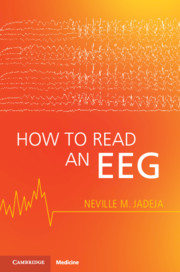Book contents
- How to Read an EEG
- How to Read an EEG
- Copyright page
- Dedication
- Contents
- Figure Contributions
- Foreword
- Preface
- How to Read This Book
- Part I Basics
- Part II Interpretation
- Chapter 9 Approach to EEG Reading
- Chapter 10 Background
- Chapter 11 Foreground (How to Describe an Abnormality)
- Chapter 12 Common Artifacts
- Chapter 13 Normal Variants
- Chapter 14 Sporadic Abnormalities
- Chapter 15 Repetitive Abnormalities
- Chapter 16 Ictal Patterns (Electrographic Seizures)
- Chapter 17 Activation Procedures
- Part III Specific Conditions
- Appendix How to Write a Report
- Index
- References
Chapter 14 - Sporadic Abnormalities
from Part II - Interpretation
Published online by Cambridge University Press: 24 June 2021
- How to Read an EEG
- How to Read an EEG
- Copyright page
- Dedication
- Contents
- Figure Contributions
- Foreword
- Preface
- How to Read This Book
- Part I Basics
- Part II Interpretation
- Chapter 9 Approach to EEG Reading
- Chapter 10 Background
- Chapter 11 Foreground (How to Describe an Abnormality)
- Chapter 12 Common Artifacts
- Chapter 13 Normal Variants
- Chapter 14 Sporadic Abnormalities
- Chapter 15 Repetitive Abnormalities
- Chapter 16 Ictal Patterns (Electrographic Seizures)
- Chapter 17 Activation Procedures
- Part III Specific Conditions
- Appendix How to Write a Report
- Index
- References
Summary
Sporadic abnormalities are those that occur in singles, pairs or in abundance but are not repetitive. They indicate cortical dysfunction, but the central question is if they are epileptogenic. They key electrographic feature to classify the waveform is its sharpness Spike and sharp waves pointed in morphology and are typically epileptogenic, these terms are often used interchangeably. Slow waves are blunted in morphology and are typically not epileptogenic (except rhythmic focal slowing).
Information
- Type
- Chapter
- Information
- How to Read an EEG , pp. 119 - 133Publisher: Cambridge University PressPrint publication year: 2021
